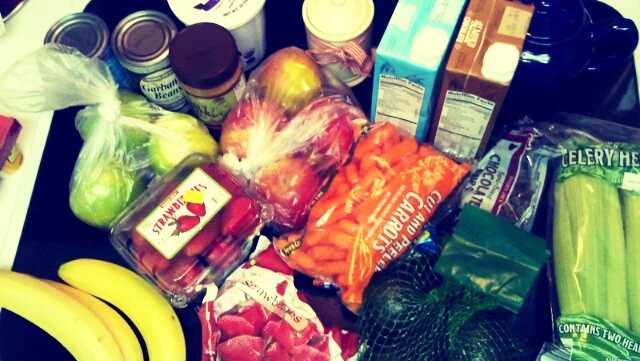

When COVID-19 broke out in the United States, one of the first corners of life that was upended was grocery shopping: The aisles stood bare as the public stocked up, and then people turned to online shopping to stay safe in their homes.But the transition online hasn't been seamless, according to a new study published Thursday.Packaged foods are required by federal regulations to have nutritional facts and ingredients available for consumers to review when they are shopping in brick-and-mortar grocery stores. But information for some products in many online grocery retailers was not listed anywhere, the study published in Public Health Nutrition found."I think it's a misconception that people don't read the food labels," said study co-author Jennifer Pomeranz, an assistant professor of public health policy and management at New York University School of Global Public Health. "People who have been diagnosed with a disease or told that they are at risk for disease, the elderly, people with children ... people with allergies. ... People read food labels for different reasons, and it's incredibly important for safety purposes."The study looked at 10 major national packaged products across nine online retailers at the start of 2021 and found that nutritional facts and ingredient lists were not included at all for almost 11% of products across retailers. In products that contained them, 63% did not disclose the presence of common food allergens, according to the study.The United States Food and Drug Administration specifies what information needs to be available to consumers. That includes serving sizes, calories, added sugars, allergens, ingredients, and daily values of sodium, sugar, carbohydrates, fats and protein."I would argue that not disclosing the nutrition facts panel and the ingredients list, including allergens, is an unfair or deceptive act," Pomeranz said.There is a limitation to the study in that the sample size is small, said Wendy White, industry manager for food and beverage at Georgia Institute of Technology, who was not affiliated with the study. White added that the small sample could limit the ability of the research to give an accurate look at the state of online nutritional information.Keeping up with COVID-19In a world where people are growing more conscientious about what is in their food, Pomeranz speculates that leaving out nutritional information is a strategy to sell packaged foods.But White thinks the issue is more logistical than strategic."The pandemic changed everything for everyone," White said. "It really expedited the growth of (online) sales in a way no one could have anticipated, and so all of a sudden this became a forefront issue."She added, "This is an excuse like any other, but I really do think with the pandemic a lot of retailers were caught unaware, and they really had to put together their online e-commerce platforms very, very quickly."For a company looking to get a lot of products to many people quickly, it's a lot easier to put a picture of the packaging online than it is to make sure all the information is easily accessible, White explained.The U.S. Food and Drug Administration is responsible for regulating labeling practices, and though White said the agency has taken steps to address the online information gap, it may take time."I think, the FDA, they are definitely taking steps to correct this gap that we currently have in some types of online food sales, but unfortunately the speed at which the FDA can create and then enforce regulations is notably slow," she said.In the past, the FDA has recommended that online nutritional information be similar to its in-store counterpart, but "we acknowledge that most of our labeling requirements pre-date online sales practices," said FDA spokesperson Courtney Rhodes. The agency has been learning more about online labeling to inform recommendations and discussed the issue at an E-Commerce Summit in October."The FDA anticipates engaging further with stakeholders on the issue to inform next steps," Rhodes said.People need to knowWhether for an allergy, diabetes, hypertension or even just being mindful of health, White said many people are cautious about what they eat."Understanding what is in a product, especially a formulated product, is vital to a lot of consumers out there," White said.The U.S. has rules and regulations about how companies disclose nutritional information, which shows both what ingredients are in the food and how much of potentially harmful elements like sodium and sugar are in a serving."The American consumer has become very used to being able to access this information very easily. They're used to going to the supermarket, picking up that can, looking at the label and understanding exactly what is in that product," White said.While policy on a national level might be slow going, the public can promote transparency from online grocery retailers with where they choose to spend their money, Pomeranz said."Online retailers have the ability to track our purchases and what we search for online, so it's important for people to know that they're not shopping on a blank slate," she said. "With that knowledge, it's worth looking around for retailers who do provide the information."Pomeranz added, "It's becoming even more of a hot topic for younger consumers, and so obviously they may have a lot of spending power. So, it would be worth it for retailers to compete on that transparency aspect."
When COVID-19 broke out in the United States, one of the first corners of life that was upended was grocery shopping: The aisles stood bare as the public stocked up, and then people turned to online shopping to stay safe in their homes.
But the transition online hasn't been seamless, according to a new study published Thursday.
Packaged foods are required by federal regulations to have nutritional facts and ingredients available for consumers to review when they are shopping in brick-and-mortar grocery stores. But information for some products in many online grocery retailers was not listed anywhere, the study published in Public Health Nutrition found.
"I think it's a misconception that people don't read the food labels," said study co-author Jennifer Pomeranz, an assistant professor of public health policy and management at New York University School of Global Public Health. "People who have been diagnosed with a disease or told that they are at risk for disease, the elderly, people with children ... people with allergies. ... People read food labels for different reasons, and it's incredibly important for safety purposes."
The study looked at 10 major national packaged products across nine online retailers at the start of 2021 and found that nutritional facts and ingredient lists were not included at all for almost 11% of products across retailers. In products that contained them, 63% did not disclose the presence of common food allergens, according to the study.
The United States Food and Drug Administration specifies what information needs to be available to consumers. That includes serving sizes, calories, added sugars, allergens, ingredients, and daily values of sodium, sugar, carbohydrates, fats and protein.
"I would argue that not disclosing the nutrition facts panel and the ingredients list, including allergens, is an unfair or deceptive act," Pomeranz said.
There is a limitation to the study in that the sample size is small, said Wendy White, industry manager for food and beverage at Georgia Institute of Technology, who was not affiliated with the study. White added that the small sample could limit the ability of the research to give an accurate look at the state of online nutritional information.
Keeping up with COVID-19
In a world where people are growing more conscientious about what is in their food, Pomeranz speculates that leaving out nutritional information is a strategy to sell packaged foods.
But White thinks the issue is more logistical than strategic.
"The pandemic changed everything for everyone," White said. "It really expedited the growth of (online) sales in a way no one could have anticipated, and so all of a sudden this became a forefront issue."
She added, "This is an excuse like any other, but I really do think with the pandemic a lot of retailers were caught unaware, and they really had to put together their online e-commerce platforms very, very quickly."
For a company looking to get a lot of products to many people quickly, it's a lot easier to put a picture of the packaging online than it is to make sure all the information is easily accessible, White explained.
The U.S. Food and Drug Administration is responsible for regulating labeling practices, and though White said the agency has taken steps to address the online information gap, it may take time.
"I think, the FDA, they are definitely taking steps to correct this gap that we currently have in some types of online food sales, but unfortunately the speed at which the FDA can create and then enforce regulations is notably slow," she said.
In the past, the FDA has recommended that online nutritional information be similar to its in-store counterpart, but "we acknowledge that most of our labeling requirements pre-date online sales practices," said FDA spokesperson Courtney Rhodes. The agency has been learning more about online labeling to inform recommendations and discussed the issue at an E-Commerce Summit in October.
"The FDA anticipates engaging further with stakeholders on the issue to inform next steps," Rhodes said.
People need to know
Whether for an allergy, diabetes, hypertension or even just being mindful of health, White said many people are cautious about what they eat.
"Understanding what is in a product, especially a formulated product, is vital to a lot of consumers out there," White said.
The U.S. has rules and regulations about how companies disclose nutritional information, which shows both what ingredients are in the food and how much of potentially harmful elements like sodium and sugar are in a serving.
"The American consumer has become very used to being able to access this information very easily. They're used to going to the supermarket, picking up that can, looking at the label and understanding exactly what is in that product," White said.
While policy on a national level might be slow going, the public can promote transparency from online grocery retailers with where they choose to spend their money, Pomeranz said.
"Online retailers have the ability to track our purchases and what we search for online, so it's important for people to know that they're not shopping on a blank slate," she said. "With that knowledge, it's worth looking around for retailers who do provide the information."
Pomeranz added, "It's becoming even more of a hot topic for younger consumers, and so obviously they may have a lot of spending power. So, it would be worth it for retailers to compete on that transparency aspect."
Source link








